27 F. average high on December 16.
22 F. high on December 16, 2013.
1" snow on the ground at KMSP.
December 16, 1996: 20 to 40 mph winds combined with recent snowfall produced blizzard like conditions for about a 36 hour period over much of the area. Whiteout conditions were common in rural and open areas. Every county road in Yellow Medicine county was impassable by the morning of the 18th. Travelers heading west were stranded in Clara City as plows were pulled off the road. Wind chills were as low as 60 degrees below zero.
December 16, 1946: Heavy snow with wind across northern Minnesota. Duluth has winds up to 62 mph.
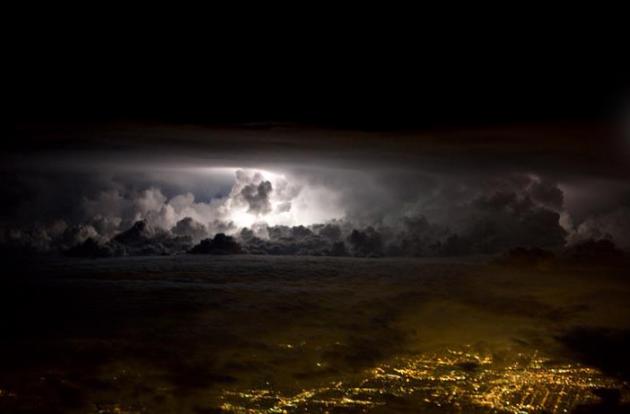
Sun Starved
"Sometimes, flying seems too godlike to be attained by man. Sometimes, the world from above seems too beautiful, too wonderful, too distant for human eyes to see" wrote the pride of Little Falls, Minnesota, aviation icon Charles A Lindbergh. I think I'm happiest when I'm in the air, up in the weather, my problems shrinking into a miniature landscape below.
Last week I boarded a Delta flight, just to see the sun. I'm happy to report our nearest star is still intact, still shining brightly. And a rare December sunshine sighting is possible the next few days as high pressure settles overhead; lighter winds & less wind chill as temperature creep above freezing by the weekend. No more 50s are in sight, but the scrawny coating of snow in your yard may be gone by early next week.
I'm close to giving up on a white Christmas. ECMWF guidance hints at a light mix on Monday, then cooling into the 20s for Christmas Eve and Christmas Day - close to average for late December.
The rumors are true: after being pampered for the last 2 weeks 2014 will end on a numbing note. The leading edge of colder air spins up a much better chance of snow in the days leading up to New Year's.
We're due.
Photo credit of squall line approaching Kansas City here.

Risk of Sunshine - Weekend Thaw. Enough dry air may percolate southward out of Canada to scour away a very persistent (and depressing) layer of low stratus clouds. The sun may peek out from time to time today, again Thursday, before temperatures return to the 30s this weekend; readings above 32F from Saturday afternoon into midday Tuesday before tumbling back down to average around Christmas. A light mix or rain is possible Monday before cold exhaust behind a clipper sparks flurries on Tuesday.

Holding Pattern. Another bubble of high pressure stalls over Minnesota Thursday and much of Friday, keeping winds light with a chance of spying the sun. As that high pressure bubble drifts east winds at the surface become more southerly, luring the mercury into the 30s this weekend, possibly topping 40F Monday before cooling back down next week. The pattern isn't ripe for major storms looking out the next week or so. NAM guidance above: NOAA.

The Scientific Way To Stay Warm This Winter. Mashable has an interesting article with some good tips; here's a clip that made me realize how little I know about staying warm: "...Being well-fed — meaning consuming more calories than you're burning — will help your body handle the cold better, according to Greenway. "It always helps to be well-fed in the backcountry when it's cold," he said. "This is all-important, to keep your blood sugar up enough to provide the energy you need to keep warm in a cold situation." Staying hydrated is also key, Greenway said. "Your body will tolerate the cold much better if food and water balance are maintained..."

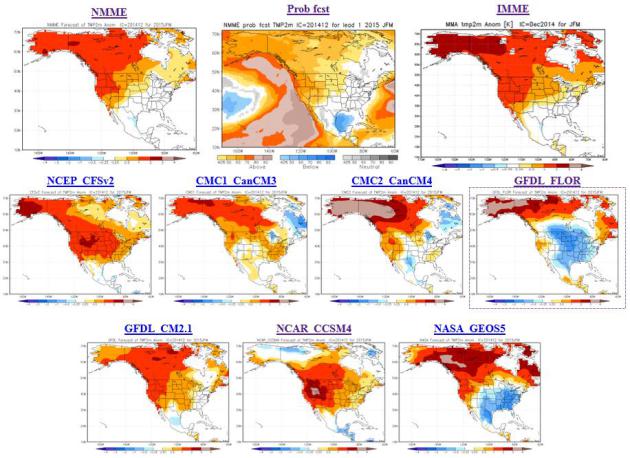
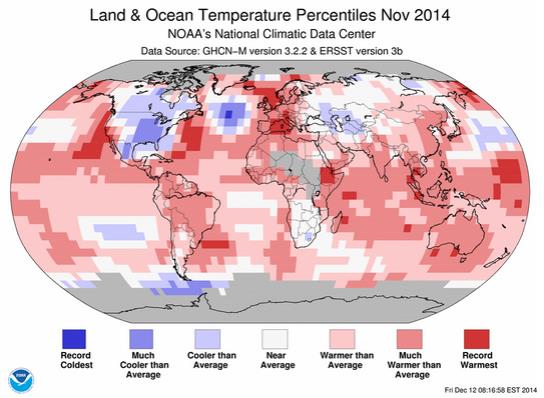
Map credit above: "November 2014 temperatures difference from 20th century average." (NOAA).



File photo above: "In this Nov. 19, 2013 file photo, small boats sit on the polluted shore of Guanabara Bay in the suburb of Sao Goncalo, across the bay from Rio de Janeiro, Brazil. A drug-resistant “super bacteria” that’s normally found in hospitals and is notoriously difficult to treat has been discovered in the waters where Rio de Janeiro’s Olympic sailing events will be held, scientists with Brazil's most respected health research institute said Monday, Dec. 15, 2014." (AP Photo/Felipe Dana, File).

Denmark Claims The North Pole? Not to hold Santa hostage, it seems, but for all the oily wealth under the (shrinking) ice cap. Here's an excerpt from Quartz: "...The race for ownership of the North Pole is hotting up.
After 12 years and $50 million of research, Denmark has surveyed the
2,000-kilometer-long underwater mountain range that runs north of
Siberia and concluded that it is geologically attached to Greenland,
the huge autonomous territory that, along with the Faroe Islands, is
controlled by Denmark. (Denmark’s broader strategy on the Arctic can be
found here. (pdf))..."

- Positive Emotion
- Engagement
- Good Relationships
- Meaning
- Accomplishment
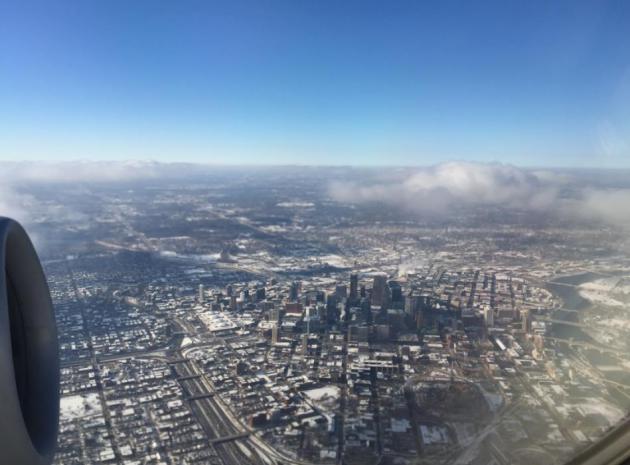
TODAY: Rare sunshine sighting? Less wind, seasonably chilly. WInds: NW 10. High: 23
WEDNESDAY NIGHT: Partial clearing late. Low: 15
THURSDAY: Few puddles of blue sky, quiet. High: 26
FRIDAY: Some sun, above average temps. Wake-up: 18. High: near 30
SATURDAY: More clouds than sun, PM thaw. Wake-up: 22. High: 34
SUNDAY: Gray, light mix possible. Wake-up: 28. High: 35
MONDAY: Light mix, mainly wet roads. Wake-up: 29. High: 39
TUESDAY: Mostly cloudy, few flurries. Wake-up: 27. High: 32
* Long range models are hinting at 20s on Christmas Eve and Christmas Day, within a few degrees of average.
Climate Stories....

Earth's Future? Ancient Warming Gives Ominous Peek at Climate Change.
Again, it's the rate of carbon release into the atmosphere that is
historic and problematic. Here's an excerpt from a story at NBC News: "...The
rate at which carbon was being released leading up to the PETM was
pretty close to the rate being released now, which is 20.9 trillion
pounds (9.5 petagrams) per year, the researchers found. "We are doing
some crazy things with the carbon cycle," Bowen says. "Carbon naturally
moves back and forth between rocks and the atmosphere at a steady slow
rate. What we are doing by burning fossil fuels is accelerating the pace
by about 30 times over the natural rate..."
.jpg)
The Lima Climate Deal Is Largely Voluntary. That May Be Its Biggest Strength. Here's a clip from a story at Vox: "...Victor has long argued
that UN negotiators would never be able to impose a climate plan on
reluctant countries from on high. Instead, any climate deal should work
from the bottom up — start with what countries are actually willing to
do and slowly build from there. And that's essentially taken in these
latest climate talks. It's not enough to avoid drastic global warming — not yet, at least. But it may be a step forward from past gridlock..."

The New Climate Denialism: More Carbon Dioxide Is A Good Thing.
Yes, and while you're at it I'd like an extra serving of mercury and
carcinogins, topped off with a tasty sample of plutonium! Never let
reality get int he way of a good argument. Here's an excerpt from The Washington Post: "...And
though Bezdek is an economist, not a scientist, he played one on Monday
— showing a PowerPoint presentation that documented a tree growing
faster when exposed to more carbon dioxide. “CO2 increases over the past
several decades have increased global greening by about 11 percent,”
the consultant said. Higher carbon levels in the atmosphere will boost
worldwide agricultural productivity by $10 trillion over the next 35
years, he added..."
“CO2
increases over the past several decades have increased global greening
by about 11 percent,” the consultant said. Higher carbon levels in the
atmosphere will boost worldwide agricultural productivity by
$10 trillion over the next 35 years, he added.

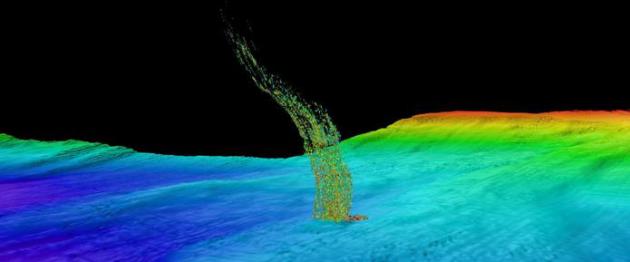
Graphic credit above: "Sonar image of bubbles rising from the seafloor off the Washington coast. The base of the column is 1/3 of a mile (515 meters) deep and the top of the plume is at 1/10 of a mile (180 meters) deep." Brendan Philip / UW.

The
rate at which carbon emissions warmed Earth's climate almost 56 million
years ago resembles modern, human-caused global warming much more than
previously believed, but involved two pulses of carbon to the
atmosphere, University of Utah researchers and their colleagues found.
Read more at: http://phys.org/news/2014-12-global-similar-today-size-duration.html#jCp
Read more at: http://phys.org/news/2014-12-global-similar-today-size-duration.html#jCp
The
rate at which carbon emissions warmed Earth's climate almost 56 million
years ago resembles modern, human-caused global warming much more than
previously believed, but involved two pulses of carbon to the
atmosphere, University of Utah researchers and their colleagues found.
Read more at: http://phys.org/news/2014-12-global-similar-today-size-duration.html#jCp
Read more at: http://phys.org/news/2014-12-global-similar-today-size-duration.html#jCp

* The final U.N. statement from Lima, Peru is here.
The CO2 argument that it is a good thing isn't new. And it ignores evidence that increasing CO2 in the atmosphere may boost plant growth, but may result in decreased crop nutrition. Of course, that research is just surfacing too, even though it's not terribly new.
ReplyDelete